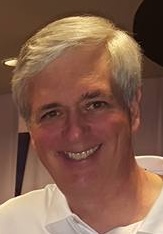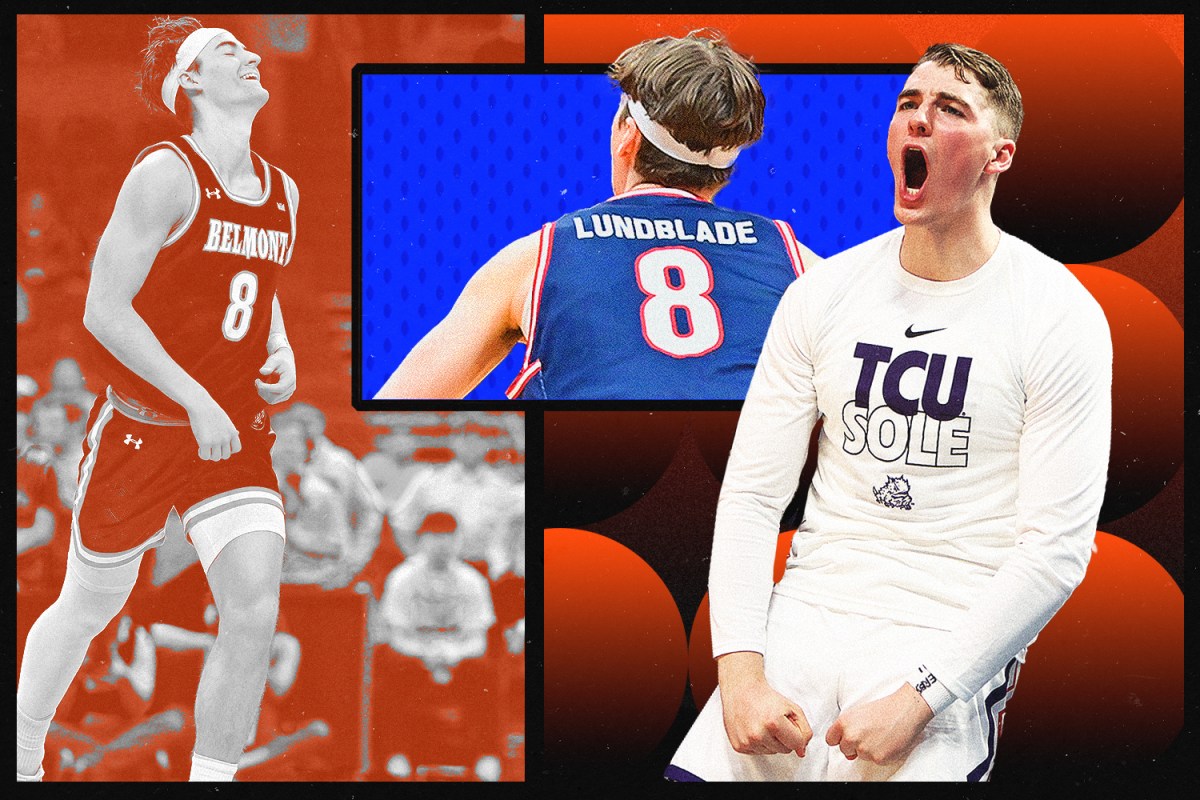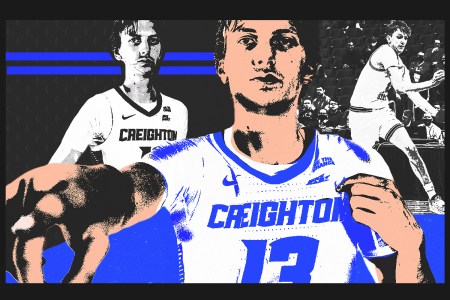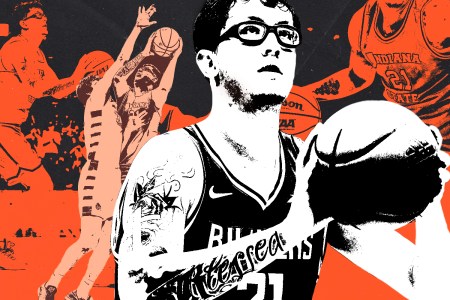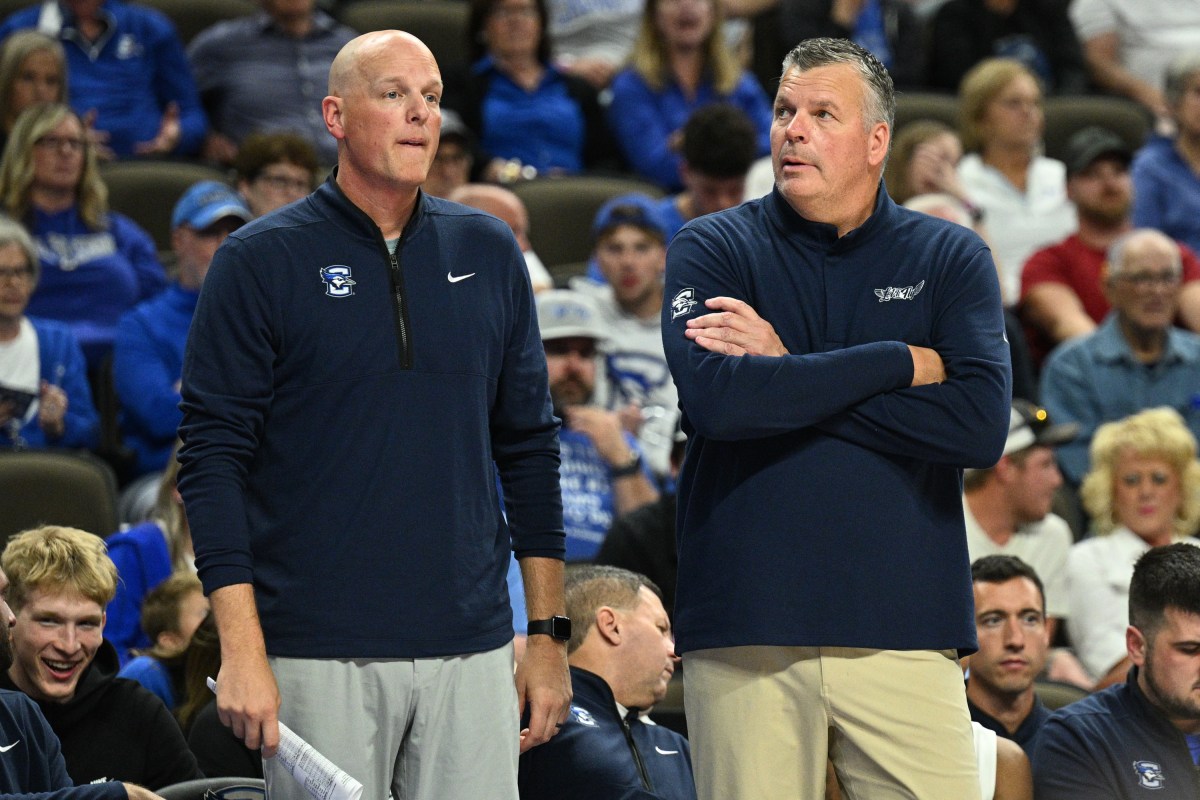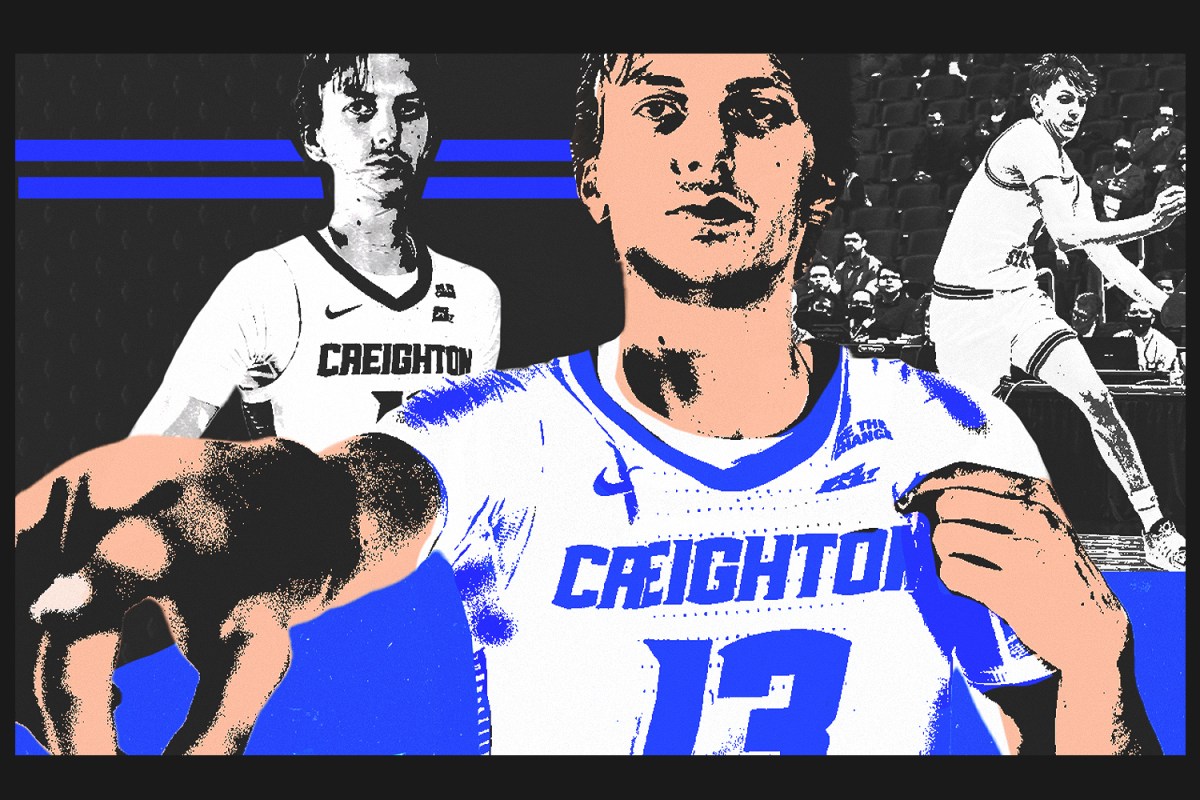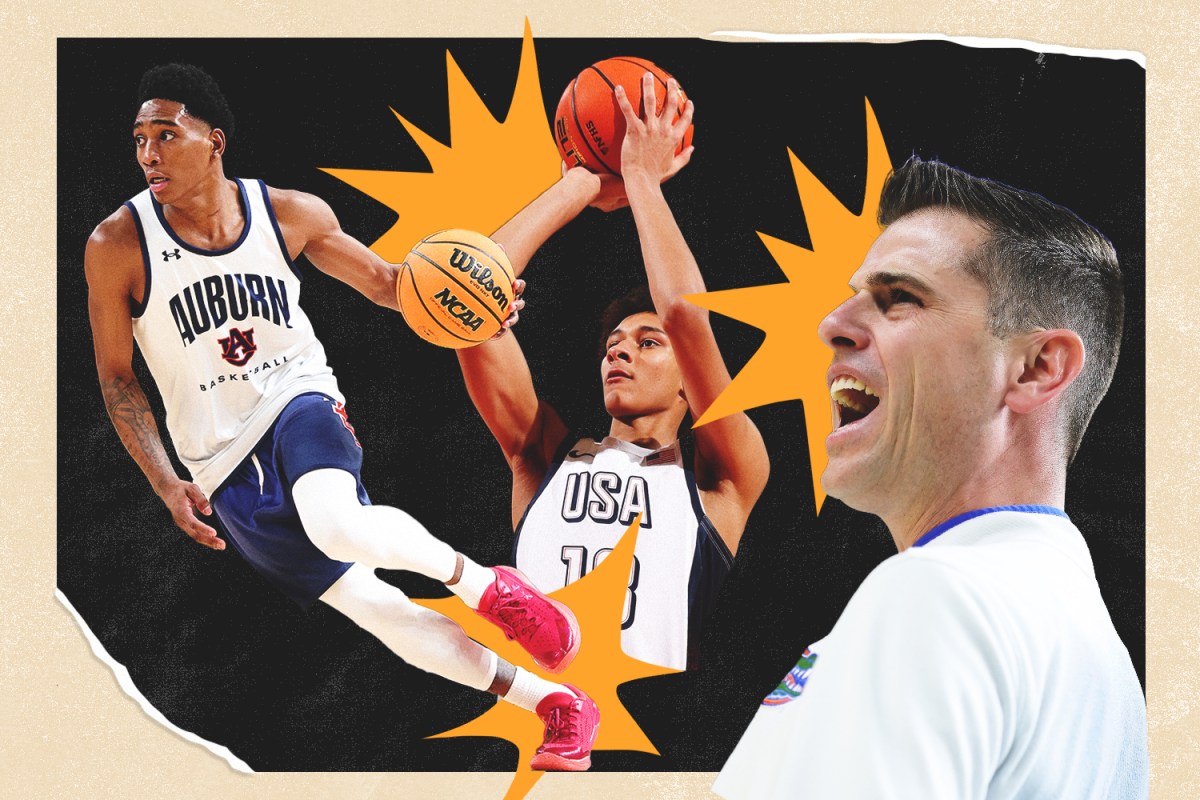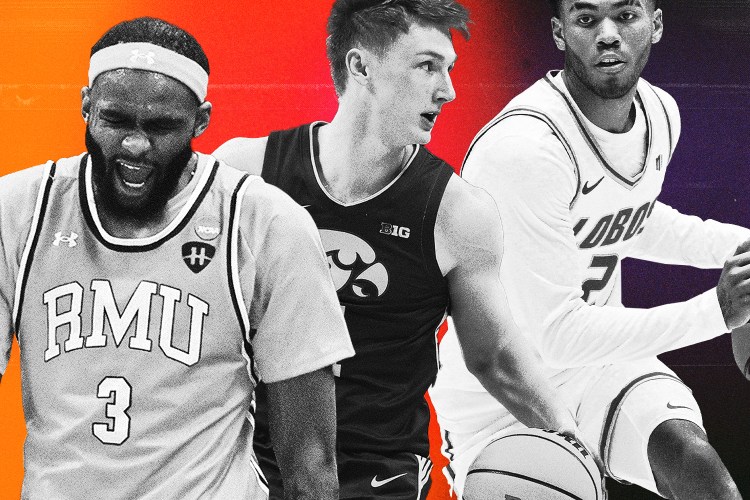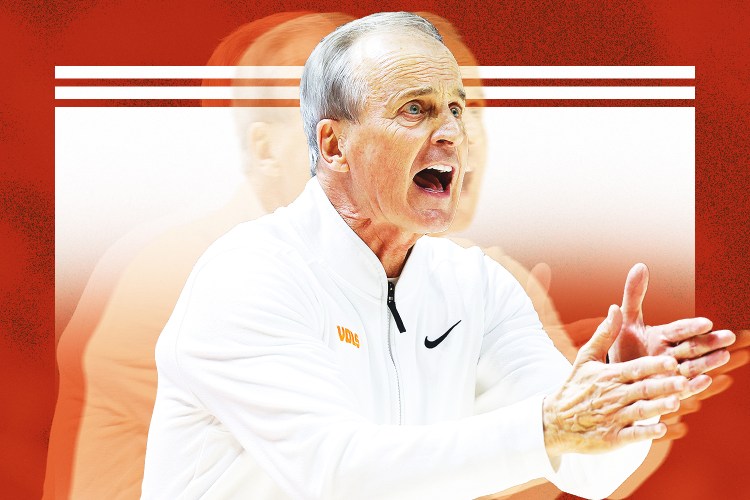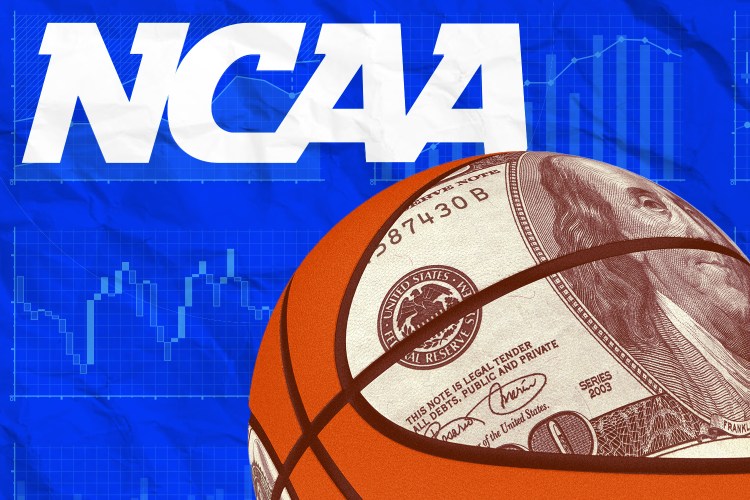On a steamy August day, the temperature inside Belmont’s basketball facility is slowly getting just as uncomfortable as it is outside. That’s because Tyler Lundblade, the Bruins’ 6-foot-5 senior wing, is methodically heating up the place with a three-point shooting drill that is getting so ridiculous — even for the man who last season led Division I in three-point percentage — Belmont graduate assistant Ryley McClaran feels compelled to preserve the moment.
The drill calls for Lundblade to shoot from five spots behind the arc and not move to the next one until he misses. On this day, Lundblade is in what he calls his “flow state.” McClaran counts the makes at Lundblade’s first spot on the floor. Ten, 20, 30, 40, 50, 60 in a row. The streak finally ends at 68.
“After he missed, I was like, ‘Whoa, he just made 68 in a row; this is getting crazy,’” says McClaran, no slouch himself from behind the arc. When he was voted Tennessee’s Class A Mr. Basketball in 2020, he shot 47 percent from three, and in a four-year career at NAIA school Freed-Hardeman, he shot 39 percent. McClaran knows all about being in the zone. “I thought, ‘He’s not slowing down,’” McClaran tells Hoops HQ. “Every shot looked the same — the mechanics, the speed. And all transferable to what we do in live play. That’s when I had to get my phone out and start recording.”
The exhibition continued, and when Lundblade was finished, his numbers were jaw dropping — of the 179 shots he attempted, he made 174. McClaran quickly sent the video to assistant coach Luke Smith, another three-point shooter of note who also played at Belmont. “I wasn’t necessarily surprised, but 68 in a row, that was a little shocking,” Smith says. “I’ve shot with him a million times and he’s made a lot in a row, but 68? He’d never done that. It’s always fun to see him do something new. He loves the opportunity to perform and show people what he can do.”
That’s all Lundblade ever wanted — a chance to show what he can do. There were more productive transfers in the country in the 2024-25 season, but considering his previous scant statistics and playing time during his college career, none of them were more surprising than Lundblade. His journey has been filled with disappointment and adversity. He began his high-school career in Texas before moving to North Carolina (Greensboro Day), where he received scholarship offers from Charlotte and FIU but turned them down because he thought he could do better. When the COVID-19 pandemic made it difficult for coaches from other schools to watch him play, he found himself in limbo, without another offer. Former SMU coach Tim Jankovich gave Lundblade a chance to return to Texas as a preferred walk-on, and he jumped at the opportunity to redshirt in 2021-22.
Lundblade performed well enough to earn a scholarship, and Jankovich was intent on playing him, but after the coach abruptly retired, his replacement, Rob Lanier, decided not to keep Lundblade on his roster. That sent Lundblade to TCU, where he also walked on and earned a scholarship. In two seasons there, he played 52 minutes spread across 15 games and scored eight points. He was 1 of 7 from three.
In May of 2024, after learning via a social-media post that TCU had signed a guard, Lundblade knew he was probably going to be on the move again. After asking for a meeting with coach Jamie Dixon, Lundblade heard the hard truth — Dixon was pulling his scholarship. By this point, the transfer portal was closed, and most schools had used up their scholarship allotments. Finding a place to play was going to be a tough task, so the family turned to Jankovich for help.

“Tyler and his family called me after the TCU situation,” Jankovich says. “They asked if I would be willing to help. Of course I would. He would have played for me had I stayed at SMU. But as late in the process as it was, I told the family it would help if any phone call I could make to help Tyler would be to a coach I knew.”
For once in his college career, Lundblade caught a break. Belmont was one of the schools on his list, and Jankovich knows Belmont coach Casey Alexander, who was an assistant at Belmont the same time Jankovich was an assistant at nearby Vanderbilt. Alexander was intrigued, but…
“When Jank first reached out (in May of 2024), we were finished with the portal,” Alexander says. “We didn’t have a scholarship.”
A month went by, and Lundblade was having no luck finding another school. “We heard back from some,” Lundblade says. “But it’s mid-June. Do you want to take a kid who hasn’t played 50 minutes in three years? Who didn’t have any production and wasn’t highly recruited (out of high school)? For me, it was all about the Lord closing all the doors and opening the right one.”
In June, Jankovich called Alexander again.
“We had a more serious conversation,” Alexander says. “This was the first time he told me Tyler could pay his own way. Then the conversation took on a different form. Taking Tyler as a walk-on was a no-brainer.”
Still, Alexander did his homework, trying to find out why a good shooter with solid positional size couldn’t find a spot on a Division I roster. “He was a specialist,” Alexander says. “I can remember talking to the (assistant coaches) at TCU about him. Tyler was their third- or fourth-leading scorer in practice. But when it came down to guarding wings in the Big 12, they just didn’t trust having him out there, no matter how many shots he could make.”
Lundblade visited Belmont on the final day of the Bruins’ summer practice sessions.
“He wasn’t with the team until everybody returned in the fall,” Alexander tells Hoops HQ. “We didn’t even know if he’d be in the rotation this time last year. We thought he would play but didn’t have high expectations.” That’s why Smith got a chuckle out of something Lundblade told him at the start of fall practice. “He told me he thought he could make 100 threes (during the season),” Smith says. “I think I laughed. Not that I didn’t have confidence in him. But he’d scored five points (in his career). I didn’t think he was going to break (former Belmont star) Ian Clark’s record (102).”
Clark’s record looked safe after Lundblade got off to a slow start.
“He seemed like he was living and dying with every shot, trying to prove himself,” Alexander says. “Not to show that he was good at what he does, but that he was elite. But the transition from being a great shooter to making shots in games is hard for anybody.”
Lundblade’s coming out party turned out to be the Bruins’ fifth game of the season, at home against Oral Roberts. He didn’t start, but in 22 minutes he scored 25 points (22 in the second half), including a game-sealing three on a play Alexander called for him. Lundblade was 7 of 9 from the field, 5 of 7 from three and 6 of 6 from the free-throw line.
Despite that outburst, Lundblade had to prove it wasn’t a fluke. By his admission, he shot the ball “only OK,” in Belmont’s first month of Missouri Valley Conference games. Then came a trip to Bradley in early February. The Bruins were shorthanded because of illness, and Alexander texted Lundblade before the game and told him to be ready to play 40 minutes. Lundblade responded with another 25-point game, tossing in eight of 13 from beyond the arc.
“Bradley is a tough place to play, and we were missing several key players,” Alexander says. “We had no business winning that game. After that, Tyler was a marked man.”
Apparently, after having been an invisible man most of his college career, Lundblade just needed someone to pay attention to him, even if it was a gang of defenders determined to not let him squeeze off a shot. Though he was getting swarmed every game, Lundblade got better. In a four-game stretch beginning with the Bradley game, Lundblade made 30 threes in 46 attempts (65.2 percent). “Seven-and-a-half threes a game,” Alexander says, laughing. “That’s when we knew. That’s when we found out he was elite.”
Lundblade made good on his prediction to Smith, finishing with 104 threes to break Clark’s single-season school record. His 48.1-percent success ratio led the nation.
“It makes me really happy what Tyler’s done with the opportunity he had,” Smith says. “He had been through some difficult situations. But I don’t know if there was a better place for him in the country on his third (college) try. A team that values shooting so much and has always had great shooters.”
It was hardly a surprise that after the season, Lundblade was bombarded with six-figure NIL offers, but he didn’t enter the portal. “I was getting texts, hearing from AAU coaches… but I never even thought about leaving,” Lundblade says. “You can’t put a price tag on the opportunity Belmont gave me, and the fact that, for once in my career, I have stability. I love Belmont, and I’ve got a special relationship with Casey.”
Alexander feels the same way about Lundblade, which is why, after watching McClaran’s video, he offered some sage advice. “Now you’re really going to be a marked man,” Alexander said.
Inside Liam McChesney’s Battle Back From Open Heart Surgery
The 6-foot-10 graduate forward, who followed coach Alan Huss from High Point to Creighton, has missed the last two years after undergoing a heart procedure
Lundblade is ready. When his daily workout regimen accidentally got mixed into the staff’s scheduling app, Alexander couldn’t believe what he saw. “He’s a freak,” Alexander says. “He does everything he can on the practice floor, plus nutritionally, sleep, personal discipline — all that stuff and more — to give himself a chance to be good. He’s a pro’s pro in every sense of the word. He’s maxing out the things he can control.”
Lundblade’s dream is to become the next Duncan Robinson, who played at Division III Williams College, which he led to a national championship, then transferred to Michigan where, in 2018, he helped lead the Wolverines to a national runner-up finish. When his college career ended, Robinson wasn’t drafted, but he signed a deal with the Miami Heat and proceeded to set numerous team three-point records and helped the Heat reach the NBA finals in 2020 and 2023.
“Nothing would give me greater joy than to help lead this team to the NCAA Tournament and be the program’s next pro (following Clark, Dylan Windler and Ben Sheppard),” Lundblade says. “I didn’t want to go to a fourth school and never get to call any place home. After struggling so long and being miserable, I’ve finally found a place where I belong and can be successful.”
Lundblade knows that to Robinson’s path to the NBA, he’s going to have to diversify his game. His workouts with Smith are intense.
“We’ve really tried to make it super hard on him,” Smith says. “Wide-open catch-and-shoot opportunities are going to be hard to come by for him. He’s got to be prepared to shoot it on a lot of different platforms and foot-works and speeds. He’s got to be prepared for what he’s going to face.”
Lundblade knows hard work will pay off. There’s a family history. His brother Brad, an offensive lineman, was a preferred walk-on at Oklahoma State, started for three-and-a-half years and then bounced around the NFL for five teams, including the Seattle Seahawks twice. “I’m extremely proud of him,” Lundblade says. “Like him, I want to give this game everything I’ve got. I’m driven.”
When he looks back on the circumstances that led to Belmont getting what turned out to be the best shooter in the country as a midsummer walk-on, Alexander shakes his head.
“More than anything, we just got lucky,” Alexander says. “This wasn’t some overnight backroom film study where our staff found a diamond in the rough. He was basically handed to us with no risk involved. We did our homework. We knew he was a great shooter, a great kid, and a great student. It was a very safe assumption he would only be an asset to our team. But there was no way to predict the success he would have. It’s an awesome story.”
